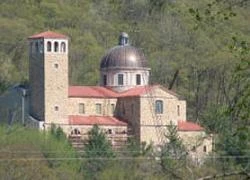
Shrine project architect Michael Swinghamer told the Milwaukee Journal Sentinel that the church is in the style of 17th-century Italianate Renaissance design. Its interior seats 450 and features Italian artwork, a 54-rank organ, Italian marble, and a mosaic of Our Lady of Guadalupe positioned behind a marble-columned canopy over the altar.
The turquoise dome bears stars in the pattern of the night sky near Mexico City in 1531, when the Virgin Mary is said to have appeared to Juan Diego. The turquoise is the same color as Mary’s mantle in the miraculous image made on Juan Diego’s cloak, which is known as a tilma.
The church’s exterior includes a tower with a 25-bell carillon and a plaza with a duplicate of the bronze statue of Juan Diego at the Basilica of Guadalupe in Mexico. The church itself sits high on a hill on a 103-acre site, which also has shaded, wooded walks among outdoor artwork pieces.
“In the tradition of pilgrimage churches, the shrine is located high upon a hill outside of the city with a campanile and dome which will be visible from afar,” said Duncan Stroik, a South Bend, Indiana church architect who worked with Swinghamer.
Archbishop Burke, who was then Bishop of La Crosse, announced plans for the project in 1999.
"Because of the loss of hope in our time and the immensity of the moral difficulties which we face, there is a great desire for a place of pilgrimage in which faith and hope can be renewed," he said at the time.
Dave Clements, executive director of the La Crosse Area Convention and Visitors Bureau, estimated that the shrine had more than 50,000 visitors last year and should get 75,000 to 100,000 visitors in 2008.
He told the Milwaukee Journal Sentinel that the shrine could top 200,000 visitors in 2010, estimating that pilgrims could bring anywhere from $6 to $10 million in income for area businesses.
Visitors to the shrine last week found some portions closed in preparation for the dedication, but were still positive.
"What we could see, I was in awe," said Iowan Linda Miller. "It's very inspirational."
Duncan Stroik, who is the director of the Institute for Sacred Architecture and an associate professor of architecture at the University of Notre Dame, described the shrine to CNA as “a very devotional building, a place for the liturgy, a place for the sacraments,” noting its three confessionals and ten shrines to different saints.
“More than a parish church, it’s a place for people to come and pray, or light a candle, or recite a rosary with their children, not necessarily just a place for the liturgy,” he continued.
The main focus of the building, Stroik explained, is upon the nave and the tabernacle to create a “crescendo” unifying the Eucharist, the liturgy, the image of the Crucifixion of Christ, and the image of the Blessed Virgin. The architects had to “develop an interior which leads your eye to the sanctuary, and in the sanctuary it all comes together.”
According to Stroik, Archbishop Burke wanted to emphasize the image of Our Lady of Guadalupe as a main focus in the church, like it is the Basilica of Guadalupe in Mexico City.
“People would see it immediately and know the focus is on the story of the Virgin and Juan Diego,” he said.
Stroik told CNA that the image of Our Lady of Guadalupe is not a photographic reproduction of the tilma, but rather a mosaic based on a very high-quality resolution photo of the original tilma.
“It allows people to see it’s the image of the tilma and not the tilma itself,” he explained.
One of the challenges of the project, according to Stroik, was to build something that was “grand and monumental” for a church that was not very large.
Stroik said that the land surrounding the shrine was “a beautiful but very steep site.” Planners, including Archbishop Burke, wanted pilgrims to “go up to house of the Lord” like the “great churches of the hill towns in Italy.” However, these aims limited the possibilities for construction.
“It was a labor of love,” Stroik concluded. “It’s been almost seven years in coming, and we’ve used artists and craftsmen from around the world.”
“It has been a great pleasure.”

1 comment:
I hope to get down there later this year, but will probably be next summer before it actually happens! Nice to have this shrine in Wisconsin...of all places!
Post a Comment